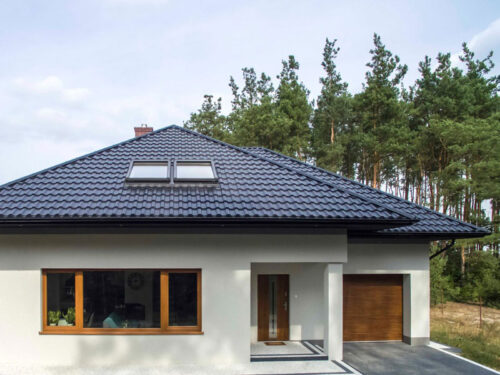Like any other type of roofing, zinc roofing needs to be properly installed to avoid future problems. Improper installation is a danger to any roofing material, but the stakes are slightly higher when it comes to zinc and other metals. This zinc roof corrosion process on the underside of metal roof panels has been well documented in the industry for many years.
Zinc roof corrosion
Zinc products will not tolerate minor leaks or condensation from the roof, preventing corrosion that can cause most metal roofing materials to fail. Most metal roofing materials can be installed on slightly sloped roofs without leaking. Whether your roof is steep or has a relatively low slope, metal works well for your roofing needs.
While zinc may or may not be the best choice for your particular situation, there are indeed many reasons to opt for a metal roof in general. If your budget isn’t that big and you don’t need something with the same durability as zinc, a metal roof that looks like zinc might be a better cost-saving alternative. Zinc is a great coating choice for people on a budget who are looking for a product that will never need to be replaced. Zinc can cost $5 to $8 per square foot in material cost alone, $10 to $20 per square foot installed.
Zinc is considered one of the most attractive roofing materials. Zinc can last 80 to 100 years when used on roofs and even longer when used as wall systems. Architectural grade zinc is also versatile and can be used as coatings and cladding to provide a smooth transition between components when required.
2 1/2″ wide strips made of zinc alloy are nailed to the top of the roof near the ridge. Zinc strips release zinc carbonate into the rainwater that washes over the roof. These bands release zinc carbonates, which are carried by rainwater over the roof and prevent this type of resistance from growing. When rainwater runs onto the roof, it picks up the zinc from the strip, and the zinc prevents further moss growth.
Moss and other problems
Once the moss dies, it can be gently washed off the roof with a pressure washer. Then use a long-handled soft-bristle brush to remove moss from the roof, scrubbing from top to bottom to avoid getting stuck on shingles.
Start by removing the shingle down to the wood sheathing and insert a strip of sticky ice and waterproofing (sold where roofing supplies are sold) under the junction between the soffit and the main roof. If you need to replace roof tiles but don’t have spare roofing materials, you can model temporary shingles from sheet metal. Once the sheet shingles are in place, you can nail them in, making sure the nails are covered with roofing concrete so the holes don’t start to leak.
Now that you’ve sealed everything tight and prepared every gap for better sealing, you can now apply urethane concrete to seal leaks in metal roofs. After you’ve used the urethane roofing adhesive and applied the fiberglass patch, you need to get it right. Before doing this, make sure you have identified any areas of damaged sealants and membranes and that you have previously applied a metal roofing primer and a glass membrane patch. Another thing to note is the use of urethane concrete suitable for your roof.
Bottom corrosion can occur when using a granular underlay or installing directly over a tiled roof, as this can scratch the protective coating on the back and cause the metal roofing system to fail from the inside out. This is because roofs will be more susceptible to corrosion in saltwater.
Metal panels and other components of zinc roof
If water has a chance to get behind or under the metal panels, moisture can get in and eventually cause serious damage to the entire roofing system. Moisture can accumulate between the roof and roof deck if a non-breathable synthetic underlay is used during installation. A leaking roof can also reach the walls and destroy paint, construction, and so on. If the metal roof has fasteners that are exposed to the street, leaks may occur.
Even if the roof was installed by professionals, a small mistake or non-compliance with the design of the metal roof leads to leaks due to overflowing gutters or solid ice in the snow season. Problems arise mainly in cases where the roof is installed incorrectly. One of the biggest factors when it comes to roof leaks is improper installation.
If your home is even partially shaded, parts of the roof that don’t receive sunlight can cause patches of moss to grow. If you have a new roof, strips of zinc or copper placed between layers of gravel will prevent moss from growing in the first place.
Algae growth
Zinc also prevents algae growth, so another option is to install a strip of zinc along the roof ridge. The layer of zinc left on the metal after the galvanizing process is intended to reduce corrosion of the metal, but it also repels the paint, eventually causing it to peel or flake off. Zinc (including granules), however, has other inherent problems such as limited ability to match the color of the tiles, method of attachment to the tiles, cost, and the occasional “bloom” effect due to zinc oxide buildup.
It is possible to install a de-icing cable on the roof, but a more permanent solution would involve blocking air leaks in the attic, strengthening the insulation, and possibly installing a self-adhesive membrane and new shingles around the perimeter of the roof. roofer.
In the end
You can temporarily fix a roof leak from inside the attic, but sooner or later you will have to fix the leak from the outside. This can be alleviated by trimming tree branches, but the roof may need to be washed once or twice a year to keep it clean and free of debris.
